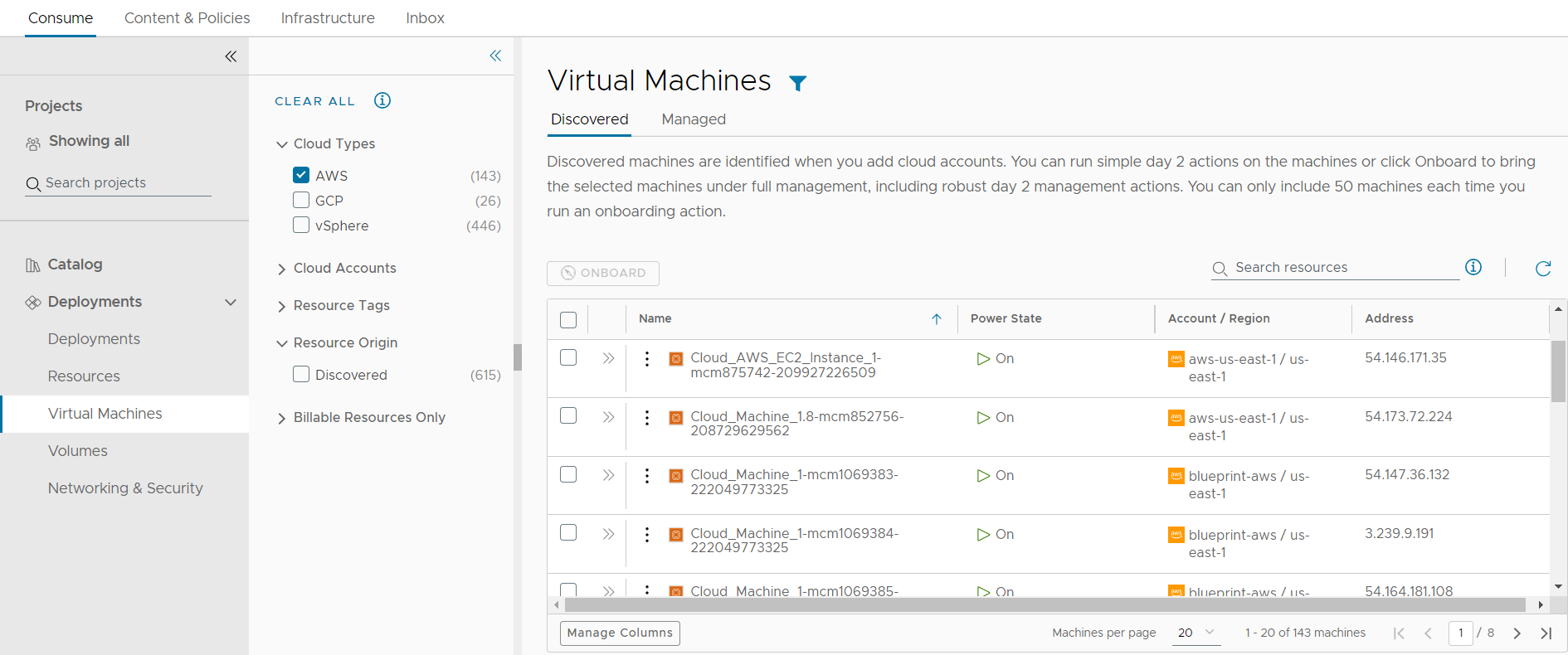If you are a Automation Service Broker administrator, you use the Resources page on the Consume tab to manage your discovered machines. Only administrators will see discovered resources on the various pages.
This workflow focuses on managing discovered virtual machines.
Locate discovered virtual machines
Discovered resources are collected from the cloud account region and added to the resources on the Deployments node on the Consume tab. This example focuses on virtual machines, but other resource types are collected, including storage and network information.
- Select .

- To locate the AWS virtual machines, click the Filter icon near the page label.
- In the filter list, expand Cloud Types and select AWS.
The list is now limited to discovered AWS virtual machines. You can see deployed, discovered, and other origin types on the Managed tab.
- To locate a particular machine, you can use the Search resources option to search by name, IP address, tags, or values.
In this example, mysql is the search term.
Review virtual machine details
The resource details include all the collected information for the resource. You can use this information to understand the resource and any associations with other resources.
- Locate the virtual machine in the Virtual Machine list.
- To view the resource details, click the machine name or click the double arrows in the left column.
The details pane opens on the right side of the list.

- Review the details, including storage, networks, custom properties, and other collected information.
- To close the pane, click the double arrows or click the resource name.
Run day 2 actions on the virtual machine
You use the day 2 actions to manage the resources. The current actions for discovered virtual machines includes Power On and Power Off. If you are managing a vSphere virtual machine, you can also run Connect with Remote Console.
- Locate the machine in the Virtual Machines list.
- Click the vertical ellipsis to see the available actions.
The possible actions for an AWS virtual machine are Power Off and Power On. Power On is not active because the machine is already on.
- Click Power Off and submit the request.

When the process is completed, the machine is powered off. You can now power it back on.
Onboarding virtual machines
You can quickly onboard discovered machines from the Virtual Machines page. Onboarding gets you full day 2 management capabilities for the onboarded resources. See What actions can I run on Automation Service Broker deployments or supported resources.
- On the Discovered tab, select the machines that you want to onboard and then click Onboard.
You can onboard up to 50 virtual machines at a time.

- Follow the prompts in the onboarding wizard.
- Select a project for the machines.
- Select if you want to group the machines into a single deployment or if you want to create a separate deployment for each machine.
- Click Next.
- Review the deployment summary. You can update the deployment name and owner by clicking the deployment name.
- When you're done, click Onboard.

The selected machines are onboarded.
- To view the deployment, go to and then click the deployment name.
- You manage your onboarded machines, go to .
If you need to onboard more than 50 machines, you create an onboarding plan. See What are onboarding plans.